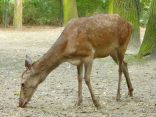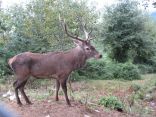- Marsupials (Diprotodontia)
- Carnivorous marsupials (Dasyuromorphia)
- Tenrec (Afrosoricida)
- Elephant shrew (Macroscelidea)
- Elephant (Proboscidea)
- Sea cows (Sirenia)
- Armadillos (Cingulata)
- Edentata (Pilosa)
- Treeshrew (Scandentia)
- Primate (Primates)
- Rodent (Rodentia)
- Bats (Chiroptera)
- Even-toed ungulate (Artiodactyla)
- Odd-toed ungulate (Perissodactyla)
- Carnivores (Carnivora)
Red deer (Cervus elaphus)
The red deer (Cervus elaphus) is one of the largest deer species. A male red deer is called a stag or hart, and a female is called a hind. The red deer inhabits most of Europe, the Caucasus Mountains region, Anatolia, Iran, and parts of western Asia. It also inhabits the Atlas Mountains of Northern Africa; being the only living species of deer to inhabit Africa. Red deer have been introduced to other areas, including Australia, New Zealand, the United States, Canada, Peru, Uruguay, Chile and Argentina. In many parts of the world, the meat (venison) from red deer is used as a food source. Red deer are ruminants, characterized by a four-chambered stomach. Genetic evidence indicates that the red deer, as traditionally defined, is a species group, rather than a single species, though exactly how many species the group includes remains disputed. The closely related and slightly larger American elk, or wapiti, native to North America and northeastern Asia, had been regarded as a subspecies of red deer, but recently it has been established as a distinct species. The ancestor of all red deer (and wapiti) probably originated in central Asia and resembled sika deer. Although at one time red deer were rare in parts of Europe, they were never close to extinction. Reintroduction and conservation efforts, such as in the United Kingdom and Portugal, have resulted in an increase of red deer populations, while other areas, such as North Africa, have continued to show a population decline.
In Aquariums and Zoos: common in Europe
In Aquariums and Zoos: common in Europe
woaqzo@yahoo.com

